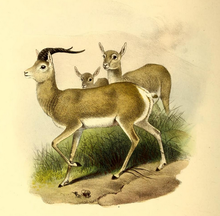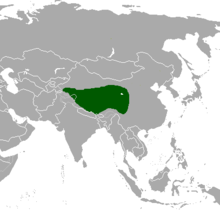Tibetan gazelle
| Goa | |
|---|---|
 |
|
| Scientific classification | |
| Kingdom: | Animalia |
| Phylum: | Chordata |
| Class: | Mammalia |
| Order: | Artiodactyla |
| Family: | Bovidae |
| Subfamily: | Antilopinae |
| Genus: | Procapra |
| Species: | P. picticaudata |
| Binomial name | |
|
Procapra picticaudata Hodgson, 1846 |
|
 |
|
| Population range | |
The goa (Procapra picticaudata), also known as the Tibetan gazelle, is a species of antelope that inhabits the Tibetan plateau.
Goas are relatively small antelopes, with slender and graceful bodies. Both males and females stand 54 to 65 centimetres (21 to 26 in) tall at the shoulder, measure 91 to 105 cm (36 to 41 in) in head-body length and weigh 13 to 16 kg (29 to 35 lb). Males have long, tapering, ridged horns, reaching lengths of 26 to 32 cm (10 to 13 in). The horns are positioned close together on the forehead, and rise more or less vertically until they suddenly diverge towards the tips. Females have no horns, and neither sex has distinct facial markings.
Goas are grayish brown over most of their bodies, with their summer coats being noticeably greyer in colour than their winter ones. They have short, black-tipped tails in the center of their heart-shaped white rump patches. Their fur lacks an undercoat, consisting of long guard hairs only, and is notably thicker in winter. They appear to have excellent senses, including keen eyesight and hearing. Their thin and long legs enhance their running skill, which is required to escape from predators.
Goas are native to the Tibetan plateau, and are widespread throughout the region, inhabiting terrain between 3,000 and 5,750 metres (9,840 and 18,860 ft) in elevation. They are almost restricted to the Chinese provinces of Gansu, Xinjiang, Tibet, Qinghai, and Sichuan, with tiny populations in the Ladakh and Sikkim regions of India. No distinct subspecies of goa have been reported.
Alpine meadow and high elevation steppe are the primary habitats of goa. They are scattered widely across their range, being present in numerous small herds spread wide apart; estimates of population density vary from 2.8 individuals per square kilometre to less than 0.1, depending on the local environment.
Unlike some other ungulates, goas do not form large herds, and are typically found in small family groups. Although they occasionally gather into larger aggregations, most goa groups contain no more than ten individuals, and many are solitary. They have been noted to give short cries and calls to alert the herd on approach of a predator or other perceived threat.
...
Wikipedia

